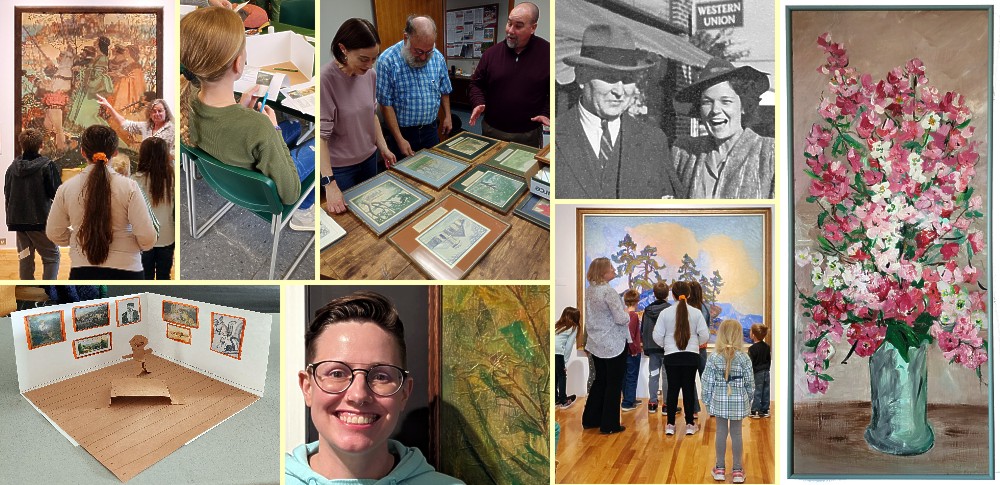Kansas Snapshots by Gloria Freeland - April 5, 2024
"To the Stars ..."
While I enjoy art, going to a gallery is not high on my list of things I find entertaining. But an exhibition I saw with sister
Gaila last fall at the Beach Museum of Art drew me back for a second visit and then a third. It's titled "To the Stars Through Art:
A History of Art Collecting in Kansas Public Schools, 1900-1950."
On my last visit, Kathrine Schlageck, associate curator of education, was guiding children and some of their parents, asking
questions to get the youngsters thinking about what they were seeing. One pointed to the vibrant colors in the 1937 painting,
"The Pageant of England," by Topeka artist David Hicks Overmyer. Others were drawn to its musical instruments. Several said the
clothing was more flowing than what people wear now.
In a classroom, a second group of students was pasting tiny photocopies of their favorite paintings on the walls of the miniature
art galleries they had created.
The exhibition is the work of a team of regional scholars, led by Elizabeth Seaton, Beach Museum of Art curator. They spent five
years traveling across the state researching the history of art collecting by Kansas' K-12 schools.
"It's been rewarding to help certain administrators recognize that they have historical treasures," Seaton said. When in
Marysville recently, she and the superintendent discovered Works Progress Administration (WPA) prints in a central office closet.
The WPA's Federal Art Program - part of President Franklin Delano Roosevelt's "New Deal" during the Depression of the 1930s -
provided jobs for artists and craftspeople in need. The art programs were also intended to serve as a source of uplift and public
enrichment. Numerous artists who worked in Kansas and are featured in the exhibition include Gustave Baumann, Woody Crumbo, John
Steuart Curry, and Grant Wood.
The exhibition's title was inspired by the Kansas motto - "ad astra per aspera" or "to the stars through difficulty" - and
references the challenge of keeping arts in education and communities. It features 70 paintings and prints and other art objects
collected by schools across the state - the first survey of art collecting by schools in Kansas.
A prominent theme is community involvement in bringing original artwork into Kansas schools.
For example, in 1911, the school superintendent in McPherson organized an exhibition to acquire art for the high school. This
became an annual event attracting more than half of McPhersons residents. Ticket sales allowed the district to establish a rich
collection of work by regionally and nationally recognized artists, among them Birger Sandzén, Fern Coppedge, and James Abbott
McNeill Whistler.
Dozens of Kansas towns and cities joined McPherson in acquiring original art through traveling exhibitions, bequests from the
Carnegie Corporation, New Deal art programs, and other avenues.
In 1926, Sandzén initiated the Midwest Art Contest to accompany the annual Midwest Art Exhibition at Lindsborgs Bethany College.
Art teachers were encouraged to submit student work, and winners received Sandzén lithographs. A top award included a one-year
scholarship to Bethany. Many contest winners went on to work as art teachers. Kansan Charles Rogers' prize-winning work was
submitted from Great Bend High School in 1929 and 1930, and he began attending Bethany in 1938. When Sandzén retired in 1946,
Rogers replaced him as painting professor.
But seven of the 14 public school systems represented in the exhibition had segregated schools. Research for the exhibit suggests
that before 1950, institutions established for non-white students lacked the same access to visual arts education, including
programs such as art collecting. One part of the exhibit explains this inequality: "Contradictions thus exist between the 'art for
all' ideals that underlie historic art collections in Kansas schools and the era's exclusionary practices. Promoters of original
art in schools expressed a desire to enhance learning environments, cultivate appreciation of 'beauty' and 'democratize' art to
strengthen American democracy. But which schools were deemed worthy of enhancement? Whose cultures and histories defined what was
'beautiful?' And who received the full benefits of American democracy?"
Gaila and I discovered we had a personal connection to one of the featured artists. My family lived in Winfield when my mother
taught there. Mom took art classes from native Kansan Sue Jean Covacevich. In the 1940s, after spending more than a decade working
and teaching in Mexico, Covacevich established herself as an artist and educator in Winfield. Her training under Sandzén and
engagement with other cultures influenced hundreds of students, from elementary pupils to adult learners.
Daughter Mariya has a painting mom did when she studied with Covacevich. Mom used twigs and different shades of green tissue paper
to create a 3-D effect. A 1969 painting mom made under Covacevich's tutelage hangs on our bedroom wall just opposite our bed. The
acrylic she titled "Fantasy in Pink" is one of the first things I see each morning.
I think Kansans are as likely as others who live in more rural areas to think great art can only be found in large metropolitan
galleries. This overlooks the fact that many artists seek out places like those where we live and some of their works remain in
those places. The "To The Stars ..." exhibit can be visited through May 11, and I recommend it.
